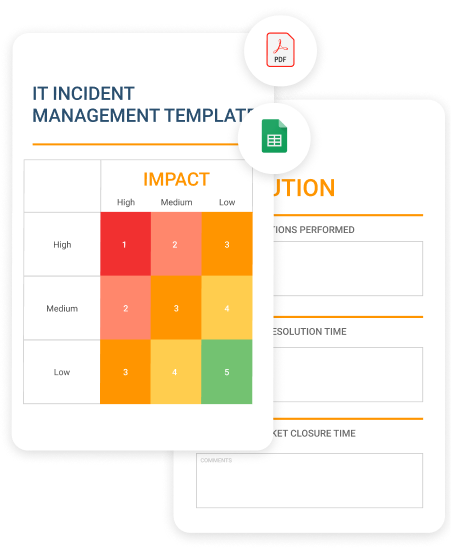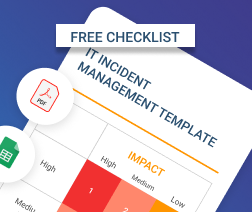MSP Business
ITIL Service Management Processes
The Information Technology Infrastructure Library, or ITIL as many IT professionals know it, is one of the most popular IT service delivery frameworks in the world today. Numerous organizations and managed IT providers have built their services according to the principles of ITIL.
In this guide, we will overview the main areas of ITIL that you should master, and also overview an ITIL service delivery framework which will help you to develop sustainable IT processes.
Incident Management
The ITIL management processes are divided into three large categories, starting from a single issue, up to infrastructural changes aiming to solve many issues at once. Incident management focuses on how you solve single issues.
So what is an incident? An incident is a single unplanned event or service disruption. Your primary goal here is to get back to normal operations as fast as possible, with minimal impact on the business. To further analyze and group incidents, you should record and classify them. This part will help you when it comes to the next big category – problem management.
The key to great incident management is a clear, concise, documented incident-solving process. Basically, it's a clear set of instructions for your team on how to discover, identify, work with, solve, and record each issue they come up with. To provide a similarly high level of services for your customers, your team should stick to these processes.
No matter how hard you try and how well you build your infrastructure, incidents will happen from time to time. And it's the incident management processes that will give your clients a feeling of quality and confidence in your services.
Problem Management
If a single or similar incident happens periodically, after you fix the incidents themselves, you should find the root cause and eliminate it. This root is called a problem.
If your users cannot remotely connect without contacting your help desk for instructions, then the root problem of such incidents is either lack of training or lack of customer-facing materials that describe the process.
Another example of a problem is constantly running out of space in Exchange mailbox. To solve this, you should restrict your users from attaching big files to their emails, upgrade your servers with bigger hard drives, or even move to a cloud solution, like Microsoft 365, where free space is less of an issue.
Problem management can be divided according to approach – either reactive or proactive. During a reactive problem management process, you should be able to quickly group incidents into a problem, find the root, and provide a feasible solution that will prevent the recurrence of the incidents.
The proactive process, though, is aimed at preventing problems that might occur in the future. For example, if your users are likely to work more from their homes, you should think of a clear remote management structure to be able to solve any upcoming issues.
Change Management
So, you have faced several similar incidents and defined the problems. Now you need to solve them. But, without a significant change in your infrastructure, this is almost impossible. In our example above, that change could be moving from an on-premises Exchange to a Microsoft 365 cloud solution.
Change management is the most strategic and complex part of the ITIL service management processes. You should carefully assess all risks, including whether or not your infrastructure is ready for that change, and whether you have enough budget, personnel, and experience in the field.
Only after you prove the concept of the change, carefully define each step and assess the risks, and document everything. It is then you should implement the change.

ITIL Service Delivery Framework
Any management processes should be built around the service delivery framework. This framework is based on the exact activities and routines you perform every day to deliver your services to the customers. It also includes your KPIs and business continuity considerations.
Service Configuration and Design
Service configuration and design is an in-depth overview of the ins and outs of your services, their functions, and deliverables. Basically, everything you do for a customer, starting from tier-1 helpdesk up to new server installments, should first be planned and outlined in such a way that it brings the maximum positive impact to your customers and business.
Service Level Management
To understand what your level of excellence is in providing services and support to your customers, you should outline and document your service level agreement. It includes the KPIs that you and your customers agreed upon and also an overview of your practices. For example, for the helpdesk, such KPIs typically include the time of first response and your escalation practices and metrics.
Once you have created and signed your SLA with a customer, you should monitor how well you keep up with the KPIs, and redefine them or make the necessary changes to your internal processes if you fail to achieve positive results. 
Further reading Top Help Desk Metrics for MSPs
Service Continuity Management
As an IT manager, you should create and ensure that your IT infrastructure is robust, and also that it can be recovered in an acceptable time frame. In the event of any planned or unplanned downtime, you should have a tested plan that will prevent your business from incurring significant losses.
Hence, service continuity management includes business continuity and disaster recovery planning. In other words, you should define the possible risks that could affect your uptime, and create recovery plans for each of those risks. Also, you should estimate the maximum tolerable time that your systems can be down in different cases. These estimations are called the recovery time and recovery point objectives.
Further reading Disaster Recovery Planning Best Practices
Conclusion
Full ITIL service management practices can seem a bit overwhelming for a small or even a medium-sized company. And this is true.
If you work in a non-enterprise environment or lead an MSP serving small and medium-sized companies, there's no point in creating and supporting the full-on ITIL framework. It will eat up your time and you will end up buried in the chaos of unnecessary processes and rules that your team cannot keep up with.
However, ITIL-based practices and approaches, when not applied excessively, can and will bring sanity to your daily routines. It can help you structure your services and focus on quality and deliverables, thus enhancing your clients' satisfaction.



